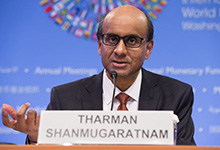INTERVIEW WITH IMFC CHAIR THARMAN

Typical street scene in Santa Ana, El Salvador. (Photo: iStock)
IMF Survey : Tharman: We Know What Needs to be Done and We Need to Do It
October 12, 2014
- Risk of prolonged low growth; need to address tomorrow's problems today
- Structural reforms can pay off now and in the future
- Action on reforms requires political courage
In an interview, Tharman Shanmugaratnam, chair of the IMF’s policy steering body, calls for countries to move quickly to adopt structural reforms in such areas as entitlement spending, labor markets and taxes to boost growth and avert a prolonged period of weak growth.

IMFC Chair Tharman: Real problem today is lack of confidence in the future.
Tharman notes that our real problem today is a lack of confidence in the medium to long term. “That lack of confidence inhibits today's activity and today's growth, “ he said. Structural reforms address this critical confidence gap, he says, citing Mexico and Spain as examples where such reforms have shown beneficial results. Reforms require some “political courage,” he said, but it means “uplifting possibilities for people, and particularly, for the youth.”
IMF Survey: The global economy seems to be stuck in a low growth, high unemployment rut. As the IMFC Chair, you have made a call to action now--a new policy momentum. What does that really mean?
Tharman: Well, first let’s acknowledge the positives, because there's been real progress since the financial crisis. The United States, the largest of advanced economies, a very important source of demand for everyone, including us in Asia, is clearly in recovery. Some countries which have undertaken tough reforms, like Spain, are seeing recovery--not just because wages have fallen and net exports are rising, but because domestic demand is recovering. Then the low-income countries are showing a vibrancy that wasn't there previously. So there are some real positives.
But overall, we are only halfway through this journey of recovering from the crisis. The Eurozone is barely recovered. We are facing new financial risks at the same time, which we have to focus on very closely. And we also face the risk of prolonged period of sub-par growth, or what the IMF Managing Director, Christine Lagarde, has called a “new mediocre.” This is a very real risk.
The point is, never treat a risk as a given. Never treat it as something preordained. We identify the risks in order to avoid them. That's the whole point of our discussions. There are ways of avoiding this risk of a prolonged period of sub-par growth.
IMF Survey: During the meetings we heard a lot of officials, both from advanced and emerging markets, talk about finding new ways to achieve new growth. They all said that structural reforms is a key. But structural reform is difficult to implement and the benefits come much later in the medium-term. How do you mobilize policymakers to act now?
Tharman: I think it's misplaced to think that structural reforms only pay off over the medium to long term.
Our real problem today is a lack of confidence in the medium to long term. That lack of confidence inhibits today's activity and today's growth.
Consumers and businesses may not be perfectly rational actors, but they do look to the future. If they're worried about the future, they curb their spending today. They curb their investments. They curb their consumption. So if we want to get out of today's problems we have to address tomorrow's problems today.
If we do that we lift confidence, and we should see some improvement even in the short-term. There are lots of examples. If you look at Spain, in fact, it's quite interesting how structural reforms in the labor market, and in some other areas, have had a relatively quick transmission into today's growth. Mexico is another classic example of how structural reforms didn't require them to go through a very long period of retrenchment or a long downturn before they finally got to the end of the tunnel.
So structural reforms address the critical gap that we see in the world today, which is confidence and trust. By bringing confidence and trust back for consumers, business, the public at large, you have the best chance of getting out of today's rut.
IMF Survey: One of the unifying themes we heard at the meetings this time was the push for infrastructure investment. How do you ensure the efficiency of this investment?
Tharman: That’s a very good point, and it's a good example of how reforms are not just necessary, but can bring real good. In public investments and infrastructure, bringing in private sector participation is not just about getting more money because it's lacking in the government budget. It's also about getting a keen eye focused on efficiency, and a keen eye focused on economic returns.
A well designed public/private partnership will often be more sustainable financially, more likely to lead to efficient project design and more sustainable operations. A lot of what we're talking about has to get past the generalities into the specifics of designing sustainable public infrastructure with private sector participation. For example, introducing standardised and transparent termination clauses in contracts can reduce the risk premiums demanded by investors, and hence reduce the costs to the public purse.
IMF Survey: What would be the one key message that you would like policymakers to take away from these annual meetings?
Tharman: That we know what needs to be done, and we need to do it. Doing it is something that requires political courage. But importantly, it involves changing the political narrative.
When we talk about labor market reforms, it's not a great sacrifice that population needs to make. It's a way of creating jobs for the young, for women, and sometimes for minorities. Is that politically unattractive? Going against vested interests doesn't mean going against the majority. It means you are uplifting possibilities for people, and particularly for the youth.







